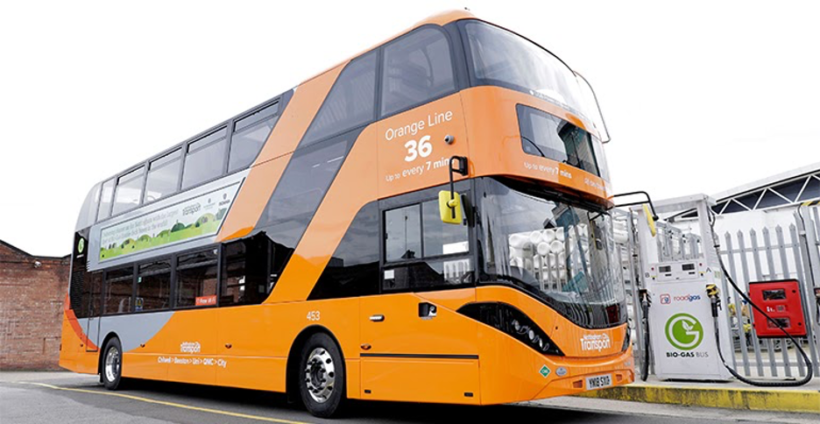 By Matthew Capuano-Rizzo
By Matthew Capuano-Rizzo
The world’s largest biogas bus fleet in Nottingham, United Kingdom. The city plans to increase orders of biogas buses and convert its 185 existing buses to the latest Euro 6 emissions standards. Such efforts have made Nottingham City Transport on track to reduce its emissions by more than 84% per year. –Bioenergy International and Bioenergy Insight
Most coverage of the climate crisis is accompanied with an uplifting segment at the end in which former Vice President Al Gore pops in to inform us that solar panel installer is the fastest growing job in America, followed by wind turbine technician. Now this is undeniably great news, but let us keep in mind that 80% of our nation’s energy still comes from fossil fuels. Global emissions hit a record 43.1 billion metric tons in 2019. Experts predict that the coronavirus lockdown, with all of the suffering and loss of life it has entailed, may reduce global emissions by 5% in 2020. According to the United Nations 2019 Emissions Gap Report, we need to reduce emissions by 7.6% every year from 2020 to 2030 to limit global warming to 1.5 degrees celsius. If we follow our current, inadequate commitments, temperatures can be expected to rise 3.2 °C above pre-industrial levels, with devastating effect.
So if a crisis fails to reduce our global emissions to the levels we need, do we have any reason to hope? While emissions are expected to bounce back next year, most of the world agrees that climate change is as serious as the coronavirus. In an Oxford University study, Nobel prize winning economist Joseph Stiglize outlined how government spending on low-carbon industries and activities would better benefit the economy in the short and long term than bailing out the fossil fuel industry. City leaders from Los Angeles to Lisbon, São Paulo to Seoul, Melbourne to Mexico City have published a ‘statement of principles,’ pledging to center COVID recovery plans around climate action. As these plans are drafted, we must save a seat at the table for renewable fuels.

What are biofuels?
99% of all biofuels produced and consumed worldwide come from food crops. Biofuel producers ferment starches from beets and sugar cane to create ethanol and ferment oils from soybeans and palm fruits to create biodiesel. Most of the biofuel produced in the United States is ethanol, derived from corn. According to the International Energy Agency, biofuel production would need to triple by 2030 to meet targets for sustainable growth. Biodiesel can also be derived from vegetable oil and animal fats. In contrast, biomethane, also known as renewable natural gas, can be captured from landfills, livestock waste, and wastewater.
Biofuels are somewhat controversial in the environmental movement due to the food versus fuel debate. Feedstocks that use grasses, algae, animal waste, grease, and wastewater may be the most preferred because they employ waste products rather than the food supply to provide fuel. Most of us have seen the 10% ethanol sticker at the gas station and it is easy to wonder if that 10% really makes any difference at all. It turns out that it does. Including 10% ethanol in 98% of motor fuel has allowed the US to reduce concentrations of tropospheric ozone and particulate matter by 21 and 26 percent respectively. In reality, biofuels are much cleaner than their 100% fossil fuel counterparts. For example, renewable diesel, a different form of biofuel made from vegetable oils and animal fats, has 80% lower emissions compared to conventional diesel.
The US leads the world in per capita carbon dioxide emissions. Each American emits more than 16 tonnes of CO2 per year. In 2018, the United States emitted 6,677 million metric tons of CO2 equivalent, according to the Environmental Protection Agency. 28% of those emissions came from transportation. Transportation represents the largest contributor to US greenhouse gas emissions largely because the number of vehicle miles traveled by passenger cars and light-duty trucks has increased by 46.1 percent from 1990 to 2018. In terms of solutions, auto-manufacturers know how to fabricate engines that can handle high levels of ethanol. Joanne Ivancic, Executive Director of Advanced Biofuels USA and member of the Maryland Clean Energy Center’s advisory board, explains that “there used to be a federal incentive to build cars that could use E85 and other high ethanol blends, but the Obama administration took that incentive away.”

How do biofuels fit into the clean energy market?
Despite many policymakers focus on an “electrify everything” approach, liquid fuels appear here to stay for the foreseeable future. This is not to say that electrification ambitions, particularly those involving high speed rail and the expansion of electric vehicles should be abandoned. Rather we must understand the reality of how fast a transition will occur. Ivancic, citing a study done by the Maryland Department of the Environment, underscored that “even if all the cars being sold in the state of Maryland are electric by 2050, half of the cars on the road will still need liquid fuel.” Thus, biofuels should not be viewed in opposition to electric vehicles (EVs), but rather in partnership with EVs. The economic effects of Maryland’s full 2019 Greenhouse Gas Emissions Reduction Act draft plan are below.

One way of achieving high levels of renewable liquid gas use lies in Advanced Biofuel USA’s proposal of a Non-Renewable Carbon User Fee that the organization recently submitted to the United States House of Representatives Committee on the Climate Crisis. As the renewable content of the fuel increases, from 10% to 85%, the consumer fee would decrease over time, from $92.40 to $17.60 per year. Instead of refunding the profits of the dividend to the American people as proposed in the Climate Leadership Council’s Plan, revenu from a “disappearing” carbon tax would be invested in research and development in renewable fuel and the construction of renewable fuel pumps across the United States. The plan emphasizes that such infrastructure should first be constructed in low-income communities that experience disproportionately more air pollution. It should be noted that such disparities are much more acute for people of color who experience on average 66% more air pollution than their white counterparts. Many countries have already begun implementing plans that have increased production and use of biofuels.

Let’s zoom out
An overemphasis on problems and solutions to the climate crisis within the United States would make our destruction seem inevitable. Despite non-negligible action at the state and local level, the United States remains the only country in the world to pull out of the landmark Paris Agreement and the Trump Administration has continued to purge climate experts, while rolling back regulations on harmful pollutants such as mercury and particulate matter. According to Greenpeace and the Centre for Research and Clean Air, air pollution costs the global economy $2.9 trillion in healthcare costs. Since many of us have been on Zoom lately, I thought we may want to ‘Zoom’ out.
Many countries are leading the charge in the realm of biofuels and beyond. Oslo, the capital of Norway employs biogas from food waste to power the city’s 135 buses. Employing renewable fuels in public transportation is particularly effective because residents forgo each taking a private car, which emits 4.6 metric tons of carbon dioxide per year. Vietnam, in a similar strategy, has begun replacing wood-burning stoves, a source of indoor air pollution, with biogas stoves, powered by pig waste. Similarly in Tanzania, the construction of more than 12,000 bio-digesters has benefitted more than 70,000 Tanzanian people with clean energy and an organic fertilizer. Across the Atlantic, Sabesp, a Brazilian company and one of the largest water and sewage companies in the world, has begun using biogas generated from its sewage treatment plan to power its vehicles. This initiative replaces 1,500 litres of diesel each day. Thus, change is possible. While electrification and growth of solar and wind energy will be essential to decarbonization, renewable liquid fuels will play an integral role in the energy transition. Biofuels facilitate circular economies by using the waste products of sewage, agriculture, and food scraps as fuel.
Bibliography
“Africa Biogas Partnership Program – Supporting Biogas Programs in Africa.” Africa Biogas Partnership Programme, 2020, www.africabiogas.org/. Accessed 7 May 2020.
“Biogas Has a Significant Role in Finland’s Goal of Carbon-Free Transport by 2045.” Bioenergy International, 13 Dec. 2018, bioenergyinternational.com/opinion-commentary/biogas-has-a-significant-role-in-finlands-goal-of-carbon-free-transport-by-2045.
Brown, Nicholas. “Biogas on Large Scale: Northern European Countries Proving It Viable.” CleanTechnica, 30 Apr. 2012, cleantechnica.com/2012/04/30/biogas-on-a-large-scale-countries-in-northern-europe-proving-it-viable/. Accessed 7 May 2020.
Environment, UN. “10 Things to Know about the Emissions Gap 2019.” UN Environment, 2019, www.unenvironment.org/news-and-stories/story/10-things-know-about-emissions-gap-2019.
Harrabin, Roger. “Can Coronavirus Crisis Spur a Green Recovery?” BBC News, 6 May 2020, www.bbc.com/news/science-environment-52488134. Accessed 7 May 2020.
Harvey, Chelsea, et al. “Greenhouse Gas Emissions to Set New Record This Year, but Rate of Growth Shrinks.” Science | AAAS, 4 Dec. 2019, www.sciencemag.org/news/2019/12/greenhouse-gas-emissions-year-set-new-record-rate-growth-shrinks.
Harvey, Fiona. “Green Stimulus Can Repair Global Economy and Climate, Study Says.” The Guardian, 5 May 2020, www.theguardian.com/environment/2020/may/05/green-stimulus-can-repair-global-economy-and-climate-study-says. Accessed 7 May 2020.
—. “UK’s Coronavirus Recovery Should Have Green Focus, Johnson Urged.” The Guardian, 6 May 2020, www.theguardian.com/environment/2020/may/06/uks-coronavirus-recovery-should-have-green-focus-johnson-urged. Accessed 7 May 2020.
Holden, Emily. “People of Color Live with 66% More Air Pollution, US Study Finds.” The Guardian, 27 June 2019, www.theguardian.com/environment/2019/jun/27/us-air-pollution-north-east-mid-atlantic-analysis-union-concerned-scientists.
Hunt, Kristin. “Viet Nam Is Developing an Unusual Energy Source.” World Economic Forum, 10 Aug. 2018, www.weforum.org/agenda/2018/08/vietnam-is-turning-pig-waste-into-biofuel-to-cut-down-on-carbon-emissions/. Accessed 7 May 2020.
“Inequitable Exposure to Air Pollution from Vehicles in the Northeast and Mid-Atlantic.” Union of Concerned Scientists, 2019, www.ucsusa.org/resources/inequitable-exposure-air-pollution-vehicles. Accessed 30 Oct. 2019.
Ivancic, Joanne. “Advanced Biofuels USA Responds to House Select Committee on Climate Crisis Request for Policy Suggestions – Advanced BioFuels USA.” Advanced Biofuels USA, 8 Nov. 2019, advancedbiofuelsusa.info/advanced-biofuels-usa-responds-to-house-select-committee-on-climate-crisis-request-for-policy-suggestions/. Accessed 7 May 2020.
—. “Advanced Biofuels USA’s Public Comment to Maryland’s Commission on Climate Change on Benefits of Biofuels in Climate Change Mitigation Plan – Advanced BioFuels USA.” Advanced Biofuels USA, 16 Oct. 2019, advancedbiofuelsusa.info/advanced-biofuels-usas-public-comment-to-marylands-commission-on-climate-change-on-benefits-of-biofuels-in-climate-change-mitigation-plan/. Accessed 7 May 2020.
—. “Northeast/Mid-Atlantic Regional Cap-and-Invest Modeling Lacks Consideration of Renewable Fuel Adoption and Infrastructure – Advanced BioFuels USA.” Advanced Biofuels USA, 18 Dec. 2019, advancedbiofuelsusa.info/northeast-mid-atlantic-regional-cap-and-invest-modeling/. Accessed 7 May 2020.
Jacobson, Louis. “The Obameter: | PolitiFact.” Www.Politifact.Com, 7 Feb. 2012, www.politifact.com/truth-o-meter/promises/obameter/promise/470/require-more-flex-fuel-cars-for-the-federal-govern/. Accessed 7 May 2020.
“Largest Biogas Project in Latin America.” Www.Volkswagenag.Com, 2018, www.volkswagenag.com/en/news/2018/12/scania_biogas_project.html#. Accessed 7 May 2020.
Lillian, Betsy. “BLS: Solar PV Installer To Be Fastest-Growing Job In 2018-28.” Solar Industry, 5 Sept. 2019, solarindustrymag.com/bls-solar-pv-installer-to-be-fastest-growing-job-in-2018-28. Accessed 7 May 2020.
McGrath, Matt. “Coronavirus: Five Charts about the Biggest Carbon Crash.” BBC News, 6 May 2020, www.bbc.com/news/science-environment-52485712. Accessed 7 May 2020.
Network, Good News. “Oslo Turns Food Waste into Fuel for Buses.” Good News Network, 16 Feb. 2014, www.goodnewsnetwork.org/oslo-plant-turns-food-waste-into-bus-fuel/. Accessed 7 May 2020.
Nunez, Christina. “Biofuels: The Benefits and Drawbacks.” Nationalgeographic.Com, 27 Feb. 2017, www.nationalgeographic.com/environment/global-warming/biofuel/.
Sixel, L. M. “Wind Turbine Techs and Solar Installers among Nation’s Fastest Growing Jobs.” HoustonChronicle.Com, 11 Apr. 2019, www.houstonchronicle.com/business/energy/article/Wind-turbine-techs-and-solar-installers-among-13759407.php. Accessed 7 May 2020.
Taylor, Matthew. “World Cannot Return to ‘business as Usual’ after Covid-19, Say Mayors.” The Guardian, 7 May 2020, www.theguardian.com/environment/2020/may/07/world-cannot-return-to-business-as-usual-after-covid-19-say-mayors. Accessed 7 May 2020.
“TCI’s Regional Policy Design Process 2019 | Transportation and Climate Initiative.” Www.Transportationandclimate.Org, 17 Dec. 2019, www.transportationandclimate.org/main-menu/tcis-regional-policy-design-process-2019.
Transport biofuels – Tracking Transport – Analysis – IEA. “Transport Biofuels – Tracking Transport – Analysis – IEA.” IEA, 2019, www.iea.org/reports/tracking-transport-2019/transport-biofuels.
“Two Thirds of Citizens around the World Agree Climate Change Is as Serious a Crisis as Coronavirus.” Ipsos, 22 Apr. 2020, www.ipsos.com/en/two-thirds-citizens-around-world-agree-climate-change-serious-crisis-coronavirus. Accessed 7 May 2020.
US EPA. “Greenhouse Gas Emissions from a Typical Passenger Vehicle | US EPA.” US EPA, 10 May 2018, www.epa.gov/greenvehicles/greenhouse-gas-emissions-typical-passenger-vehicle.
“U.S. Renewable Energy Factsheet | Center for Sustainable Systems.” Center for Sustainable Systems: University of Michigan, 2018, css.umich.edu/factsheets/us-renewable-energy-factsheet.
Victor, David G. “The Pandemic Won’t Save the Climate.” Www.Foreignaffairs.Com, 7 May 2020, www.foreignaffairs.com/articles/2020-05-07/pandemic-wont-save-climate. Accessed 7 May 2020.



Leave a Reply